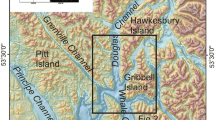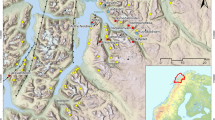Abstract
The Trotternish Peninsula on the Isle of Skye, Scotland, has been subject to a series of Late Glacial and on-going postglacial slope instability. The area of landsliding extends over a length of approximately 45 km and a maximum width of 6.5 km along the eastern side of the peninsula, making this one of the largest landslide complexes in Europe. A series of Tertiary lava flows (Skye Lava Group) and concordant intrusions resting on and within a sequence of Upper Jurassic marine sediments form a west-tilted plateau. The eastern scarp face has failed as a series of interlinked failure blocks. Detailed field mapping, involving geomorphological and structural analysis, has identified a more complex mode of failure than previously recognised, involving rotation, toppling, planar sliding, rockfalls, mudflows and ‘sackung-like’ gravitational spreading. The boundaries between adjacent landslide blocks and the zones of different modes of failure are often demarked by pre-existing structure, including fault zones, dyke intrusions and major joint sets. The basal slip plane, at least in part, appears to have reactivated syn-depositional listric faults within the Jurassic marine sequence. This paper presents a revised structural interpretation for this remarkable landslide complex and highlights the hazard to local infrastructure from continuing slope movements.
Access provided by Autonomous University of Puebla. Download conference paper PDF
Similar content being viewed by others
Keywords
1 Introduction
The Trotternish Peninsula on the Isle of Skye, Scotland, comprises a sequence of Palaeogene alkali basalt lava flows resting on a Middle Jurassic marine sequence including sandstones, shales, and limestones of the Great Estuarine Group (Anderson and Dunham 1966). These rocks are intruded by the Little Minch Sill, a sequence of structurally transgressive layered and columnar doleritic intrusions; individual sills are 10 to over 100 m in thickness. The entire sequence is tilted gently to the west. The region is also divided into a series of fault-bounded blocks by north–west and north–south striking faults. A number of these faults are also intruded by late-stage dykes. The region was extensively glaciated during the Late Devensian, resulting in the development of a series of east-facing glacial cirques. In addition, the offshore region to the east of Trotternish (The Inner Sound) has been subject to extensive glacial erosion and over-steepening of the eastern margin of the peninsula, leading to extensive landsliding. The slope failures along the Trotternish Peninsula are cited by Ballantyne (2007) as being the largest in Britain, covering an area in the order of 40 km2 (Fig. 182.1). However, despite their size, surprisingly little work has been carried out to understand the mechanism of failure, particularly in the northern part of the peninsula around the Quiraing and at the southern end near Ben Tianavaig. Previous investigations have interpreted the mode of failure as progressive rotation, with the slip plane located at the contact between the Upper Jurassic sediments and the transgressive Little Minch Sill (Anderson and Dunham 1966; BGS 2006). The driver for failure is slope over-steepening and gravitational collapse. Through extensive geomorphological investigation Ballantyne (1991, 2007) formed a view that the landslides were the result of translation rather than rotation. Ballantyne (2007) also recognised zonation within the landslide complex: an inner zone, closer to the cliffs forming the headscarp, characterised by sharper, angular blocks where movement occurred after the last ice sheet retreated. The second is an outer zone; closer to the sea, where more rounded, hummocky terrain can be seen; this is considered to be the result of older slope movement that has since been eroded by ice. The eastern coast of Skye was subject to extensive glacial erosion during the Late Devensian leading to (possibly structurally-controlled) over-deepening of the Inner Sound between the island and the Scottish Mainland. The decay of the ice mass at the end of the last glaciation left an area of over-steepened slopes along the east coast of Skye and the neighbouring island of Raasay. Coastal erosion, especially near the northern part of the peninsula, causes continued movement today.
2 Current Investigations
The Trotternish landslides have been the subject of investigation by M.Sc. Engineering Geology students at Imperial College over the last few years. Initial reconnaissance investigations showed that the previously proposed simple rotation and translation models did not explain the apparent complex nature of the landslides in the area of the Quiraing. Using a combination of remote sensing analysis, geomorphological and detailed structural and stratigraphic mapping, two areas of the main landslide complex, the Quiraing (Martin 2011) and Ben Tianavaig (Cheng 2013) and one outlying area, Glen Uig (Murphy 2011), have been investigated. Google Earth imagery has proven extremely useful for initial ground evaluation, allowing the development of preliminary engineering geomorphological maps. Field mapping investigating the mechanism of failure, concentrated on structural analysis and stratigraphic mapping. As the majority of the exposed material in the landslide complex is Paleogene lava flows, many of which have uniform structure, the stratigraphy and structural attitude of individual blocks was determined using the distinctive paleosols developed on the top of many of the lava flow sequences. Individual horizons were mapped based on their colour and thickness (Fig. 182.2). This allowed correlation across adjacent slipped blocks, and the attitude of these horizons were used to determine the relative rotation of each block compared to the flows exposed in the headscarp.
3 Results
The Quiraing landslide complex can be simplified into: an inner zone of postglacial failure close to the present-day headscarp, where toppling, translation and minor rotation are the predominant failure mechanisms (Fig. 182.3); a glacially smoothed transition zone where the exact mode of failure has yet to be clearly determined; an outer zone along the shoreline of the peninsula, where the failure concerns the reactivation of Late Glacial rotated blocks in Jurassic mudstones that are now subject to erosion, toppling and extensive mudflows. On-going failure, especially at the northern end of the mapped failure near Duntulm and Flodigarry, is driven by continued coastal erosion of weak mudstone horizons that outcrop at the toe of the slide mass. Martin (2011) demonstrates that the structure developed during the creation of the Hebridean basin and the opening of the North Atlantic exerts a strong control on the overall morphology of this area of landsliding. The backscarp and many of the slide blocks have rectilinear geometries (Fig. 182.3) controlled by pre-existing discontinuities. The overall rotational nature of the toe of the failure and the coincidence between the boundaries of differing slide behaviour indicate that syn-depositional listric faults within the underlying Jurassic sequence may have been reactivated during this latest phase of movement. Although the majority of the slope movement appears to be relict, there are areas of ongoing movement, especially where the toe of the slide is expressed in weak, thinly laminated shales exposed at sea level.
Complex landslide block geometry at the northern end of the Quiraing. View northeast across to Leac nan Fionn. While the outer blocks (A) have mainly moved outwards with little or no rotation, an extensional zone (B) has developed behind with a series of inward and outward rotated blocks forming a series of linear scarps and ridges (Modified from Martin 2011)
At Ben Tianavaig the Paleogene lava sequence has been displaced down-to-the-east, as a series of back rotated slide blocks (Fig. 182.4). Like the Quiraing, this is also a failure controlled and constrained by pre-existing structure. The headscarp is bounded by northwest and east-southeast discontinuities; these are faults, dyke, and dyke-intruded joints. The main slide mass has remained relatively intact and therefore does not show the complex morphology displayed at the Quiraing. Whether this is a result of a differing failure mechanism or a reflection of a more limited transport distance along the slip plane is not yet determined.
View of Ben Tianavaig from the southeast. The headscarp (arrow) is marked by the prominent step. The slipped mass (A) is marked by the prominent hummocky terrain. This incorporates large rotational blocks as well as a smaller component of toppling (T). Areas of recent rockfall and debris flow activity are shown by the smooth colluvial aprons (C) on the lower slopes (Modified from Cheng 2013)
In Glen Uig (known locally as Fairy Glen) secondary zones of slope instability are also developing along the western dip-slope (Fig. 182.5) of the tilted plateau where postglacial fluvial down cutting has exposed underlying Jurassic sediments leading to over-steepened slopes, valley bulging and predominantly planar sliding on bedding planes within the mudrock sequence or at the lava-sediment interface.
Overview of the landslide complex on the southern margin of Glen Uig. The lower slopes (A) show older, rounded (ice-moulded?) slipped block that show indication of back rotation. The upper slopes (B) show more angular slipped blocks as a consequence of translation or minor toppling (Modified from Murphy 2011)
4 Conclusions
Careful analysis of remote sensing data, combined with detailed geomorphological, structural and stratigraphic mapping has allowed the development of a new interpretation for the mechanism of failure along the Trotternish landslide complex. The mode of failure, involving rotation, translation, and toppling, is similar to other large landslide complexes seen in similar terrain worldwide.
References
Anderson FW, Dunham KW (1966) The geology of Northern Skye. Memoir of the Geological Survey of Great Britain, H.M.S.O., London, 216 p
Ballantyne CK (1991) The Trotternish landslides, Isle of Skye. Scott Geogr Mag 107:130–135
Ballantyne CK (2007) Trotternish escarpment, Isle of Skye, highland. In: Cooper RG (ed) Mass movements in Great Britain, geological conservation review series, No. 33, Joint Nature Conservation Committee, Peterborough, pp 196–204
Cheng MC (2013) An engineering geomorphological study on the Ben Tianavaig landslide, Isle of Skye, Scotland, Unpublished MSc Thesis, Imperial College, London, 62 p
Martin P (2011) Engineering geological assessment of the Quiraing landslide complex, Isle of Skye, Unpublished MSc Thesis, Imperial College, London, 42 p
Murphy B (2011) a geomorphological and geological assessment of Glen Uig, Isle of Skye, Unpublished MSc Thesis, Imperial College, London, 68 p
Author information
Authors and Affiliations
Corresponding author
Editor information
Editors and Affiliations
Rights and permissions
Copyright information
© 2015 Springer International Publishing Switzerland
About this paper
Cite this paper
Fenton, C., Martin, P., Cheng, F., Murphy, B. (2015). Geomorphological Analysis of Large Scale Slope Instability, Trotternish, Isle of Skye. In: Lollino, G., et al. Engineering Geology for Society and Territory - Volume 2. Springer, Cham. https://doi.org/10.1007/978-3-319-09057-3_182
Download citation
DOI: https://doi.org/10.1007/978-3-319-09057-3_182
Published:
Publisher Name: Springer, Cham
Print ISBN: 978-3-319-09056-6
Online ISBN: 978-3-319-09057-3
eBook Packages: Earth and Environmental ScienceEarth and Environmental Science (R0)









